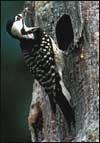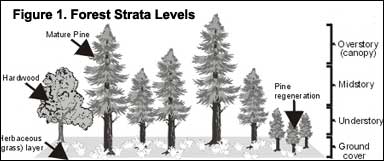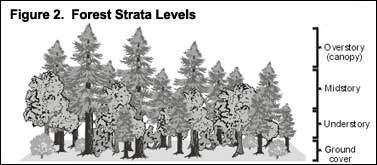Red-cockaded Woodpecker
Habitat

The RCW adapted to open, mature pine forests throughout the southeastern U. S. Although this open, grassy condition was historically maintained by lightning-created fire, the early American Indians also used fire as a means for creating this forest condition (Figure 1).

Figure 1. Forest strata levels of hardwood trees, mature pines, pine regeneration, overstory (canopy) midstory, understory, and herbaceous (grass) ground cover layer.
By maintaining the open condition of these pine forests, sunlight reached the forest floor which produced a diverse herbaceous, vegetative ground cover that supported important sources of food for the Indians such as white-tailed deer, northern bobwhite (quail) and Eastern wild turkey. The historic, open, fire-maintained pine stands are very “park-like,” and are sometimes called “pine savannahs” or “pine sandhills.” These sites usually occur in very deep sandy sites along hillside ridges, but they can also occur elsewhere on the landscape like in wetter, clay soil types.

Figure 2. Forest strata levels of dense forest with overstory (canopy), midstory, understory, and ground cover.
The suppression of fire in the last 100+ years has allowed a thick mass of woody plant species to grow, reducing habitat for nesting bobwhite and turkeys, as well as the preferred habitat for RCWs. When the woody plants grow to a height of 15 feet or more (termed midstory), RCWs usually abandon the site (Figure 2).
A unique characteristic of the RCW is that it is the only North American woodpecker species that excavates its cavity exclusively in living pine trees. To make cavity excavation easier, the bird typically chooses old pines (80+ years) infected with a fungus called heart rot, which decays the inner wood of the tree.
Wildlife Diversity Program
Texas Parks and Wildlife Department
4200 Smith School Road
Austin, TX 78744
or send a message to: nature@tpwd.state.tx.us